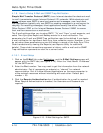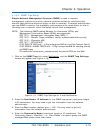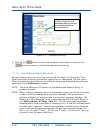
Chapter 4: Operation
724-746-5500 | blackbox.com 4-19
4.1.8.2. SNMP Trap Setup
Simple Network Management Protocol (SNMP) is used in network
management systems to monitor network-attached devices for conditions that
warrant administrative attention either on-site or remotely. A network administrator
can use SNMP to monitor the availability-performance-error rates either on-site or
remotely over a network, which facilitates central clock management.
NOTE: The following SNMP-related Request for Comments (RFCs) and
Management Information Bases (MIBs) are supported:
RFC 1213 – Management information Base (MIB) II
RFC 1215 – Generic Traps (coldStart, linkUp, authenticationFailure only)
RFC 1316 – Character MIB
RFC 1317 – RS-232 MIB
DIGI-DEVICE-INFO.mib – A Digi enterprise MIB for the Digi Connect Family
DIGI-SERIAL-ALARM-TRAPS.mib – A Digi enterprise MIB for sending alarms
as SNMP traps
For additional information, please consult the above RFCs on the Web.
1. Click on the SNMP Trap link under Notification, and the SNMP Trap Settings
screen will appear (see Figure 4-19).
Figure 4-19. SNMP Trap Settings for E-mail Notification.
2. Enter the Host Name/IP Address for the SNMP trap server (maximum length
is 50 characters). You may need to get this information from the network
administrator.
3. Enter the Port number (default port = 162). You may need to get this
information from the network administrator.
4. Enter the Community Name (maximum length is 10 characters). The
Community Name (“Identifier”, i.e., Time Clocks”) is used to group the SNMP
managed Web clocks under that name.


















